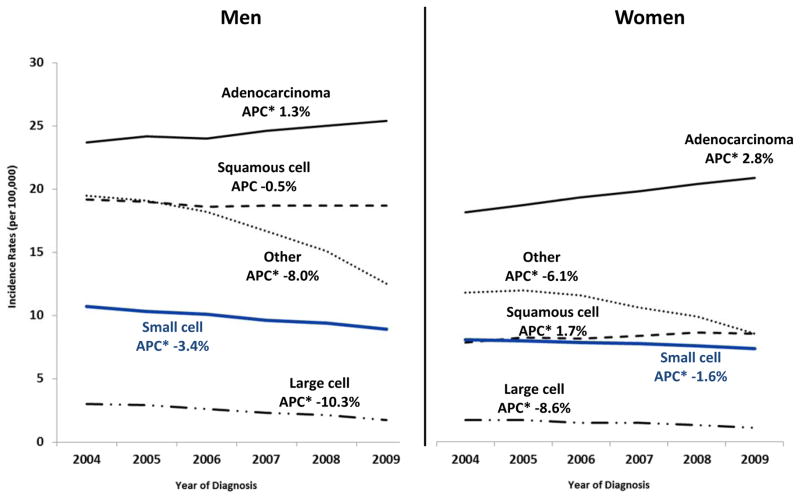Figure 2.
Lung Cancer Incidence Trends by Sex: Small Cell vs. Non-Small Cell Lung Cancer Subtypes—United States, 2004–2009a
Data are from population-based registries that participate in the National Program of Cancer Registries and/or the Surveillance, Epidemiology, and End Results and meet high-quality data criteria. These registries cover approximately 98% of the U.S. population.
Lung cancer histology groups were defined using International Classification of Diseases for Oncology version 3 (ICD-0-3): non-small cell carcinoma (8010-8015, 8020-8022, 8030-8040, 8046, 8050-8052, 8070-8084, 8090-8110, 8120-8131, 8140-8156, 8160-8162, 8170-8175, 8180, 8190-8221, 8230-8231, 8240-8263, 8270-8280, 8290-8337, 8340-8347, 8350-8390, 8400-8562, 8570-8576, 8580-8671, 8940-8941), small cell carcinoma (8041-8045). Non-small cell carcinomas were further categorized as squamous cell (8051-8052, 8070-8084, 8120-8131), adenocarcinoma (8050, 8140-8149, 8160-8162, 8190-8221, 8250-8263, 8270-8280, 8290-8337, 8350-8390, 8400-8560, 8570-8576, 8940-8941), large cell carcinoma (8011-8015), and Other non-small cell carcinoma (8010, 8020-8022, 8030-8040, 8046, 8090-8110, 8150-8156, 8170-8175, 8180, 8230-8231, 8240-8249, 8340-8347, 8561-8562, 8580-8671).
a Rates are per 100,000 and age-adjusted to the 2000 U.S. Std Population (19 age groups—Census P25-1130) standard
* Annual percent change (APC) is significantly different from zero (p<0.05)

